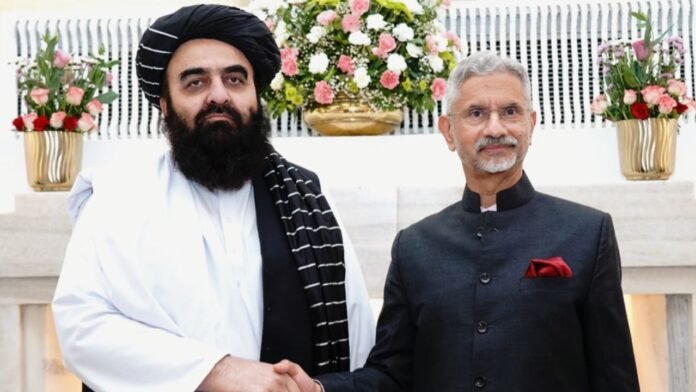The Depth That Collapsed: Afghanistan has often been called the graveyard of empires, but it may well become the mirror that shatters Pakistan’s illusions. For decades, Pakistan sold the idea of ‘strategic depth’, using Afghanistan as a buffer, training ground, and ideological extension. That strategy has collapsed under its own deceit. The Frankenstein it nurtured now haunts its creator, rejects the Durand Line, and uses the TTP (Tehreek-e-Taliban Pakistan) to strike it. Karma has struck back at Pakistan.
The Turn of the Tide
The visit of Afghanistan’s Interim Foreign Minister Amir Khan Muttaqi to India has become a turning point beyond diplomacy. It exposed a turning of the regional tide. On one side stood India, calm, deliberate, ready to rebuild ties through legitimacy and humanitarian aid. Dr Jaishankar spoke of partnership, dignity, and shared security. He didn’t need to name Pakistan. The contrast spoke for itself. On the other side, Pakistan reacted with airstrikes and outrage. Airstrikes pounded Afghan territory even as Muttaqi’s visit is still underway. It was panic disguised as policy. The same country that once claimed Afghanistan as ‘strategic depth’ now finds itself flailing on the defensive. Islamabad’s problem is not the Taliban. It is its own addiction to control without competence, a doctrine of ‘Terror Niti’, where ideology replaces insight and violence substitutes for statecraft.
The difference between Terror Niti and Chanakya Niti: Terror Niti feeds on shortcuts, proxy wars, sermons, and manufactured threats. Chanakya Niti invests in the slow art of credibility, patience, planning, and quiet strength. Pakistan’s doctrine seeks control without responsibility; India’s seeks influence through trust. One isolates; the other integrates
The Price of Proxies
For forty years, Pakistan believed it could rent out geography and religion for strategic returns. It hosted the Mujahideen, cultivated the Taliban, played both ally and adversary to the United States, and pocketed rewards for it all. Every proxy came with a price. Every success planted the seed of the next failure. Today, the bill has arrived. Pakistan’s formula was simple enough: fund the faithful, arm the willing, and control the rest through dependency. It worked when global powers indulged it; first the Americans during the Cold War to oust the Soviets, then the Chinese under Belt and Road optimism. But when the Americans withdrew and the Chinese grew cautious, the scaffolding came apart. The Taliban no longer needed their benefactor. They had victory; they wanted respect, not instruction.
The Border That Bleeds
The Taliban have no interest in being Pakistan’s clients. They reject the Durand Line, ignore Pakistani threats, and host the Tehreek-e-Taliban Pakistan (TTP) that now hunts Pakistani soldiers on their own soil. The border, once called ‘strategic depth’, has become a bleeding edge. Every drone strike that crosses it is a confession of failure. Inside Pakistan, the cost is heavy, with the areas along the Durand line and in Khyber Pakhtunkhwa turning into war zones with ambush and cross-border attacks rampant. The state fights the Frankenstein it created once. Refugees driven out in the name of security have become the new face of resentment. When Pakistan expelled over a million Afghans, it imagined leverage; it earned hatred. The Taliban turned that move into propaganda, accusing Islamabad of betrayal and cruelty. For a country built on narratives, losing the moral story is fatal.
Afghanistan is again where the world’s rivalries intersect. Moscow is reclaiming lost ground in Central Asia, wary of Western drift. Beijing wants Afghan minerals and overland access but fears the infection of extremism along its western rim. Washington’s interest in Bagram is clear; a vantage point that still offers reach, eyes, and response capability across a volatile arc
Chanakya Niti in Motion
India, by contrast, is writing a different script. It is not rushing to fill the vacuum in Kabul with speeches or slogans. The presence is humanitarian and development-based: trade, communication, hospitals and schools. There are no militias in India’s strategy, no hidden clauses, no sermons about ideology. What New Delhi offers Kabul is simple: stability through cooperation, growth through projects, and respect through dialogue. That is Chanakya Niti in motion: quiet, deliberate, patient. Strategy with ethics. Power with restraint.
When Dr Jaishankar met Muttaqi, his words were quiet but sharp. “As a contiguous neighbour and a well-wisher of the Afghan people, India has a deep interest in your development and progress.” That line carried weight. The term “contiguous neighbour” was deliberate, a reminder that through the narrow Wakhan Corridor, Afghanistan touches the part of Jammu and Kashmir under Pakistan’s illegal occupation. Geography was turned into subtle statecraft.
Jaishankar added another pointed remark that both India and Afghanistan suffer from cross-border terrorism. Coming hours after Pakistan’s airstrikes, it was polite but devastating. The Taliban, eager to balance its position, promised that its soil would not be used against India by any nation and expressed gratitude to India for pandemic vaccines to earthquake relief.
This was more than diplomacy. It was India reclaiming space that Pakistan had monopolised for decades. For Kabul, it was a partnership. For Islamabad, it was humiliation. That exchange redrew South Asia’s strategic map. India and the Taliban were resetting ties on proximity and parity, while Pakistan was left isolated. The message was clear: if India can engage Kabul through legitimacy, Pakistan’s monopoly through manipulation is over.
Pakistan in Panic: Terror Niti Fails
Pakistan’s reaction betrayed nervousness. Its generals understand what influence by legitimacy means, and they have none left. For seventy-five years, Islamabad’s rulers mistook control for strategy. They saw ideology as insurance. Now both have turned into liabilities. The Taliban, confident in their own sovereignty, play Pakistan’s dependence against it. By allowing the TTP space, they ensure that Rawalpindi cannot rest easy. The more Pakistan threatens, the more Kabul asserts.
The difference between Terror Niti and Chanakya Niti lies here. Terror Niti feeds on shortcuts, proxy wars, sermons, and manufactured threats. Chanakya Niti invests in the slow art of credibility, patience, planning, and quiet strength. Pakistan’s doctrine seeks control without responsibility; India’s seeks influence through trust. One isolates; the other integrates.
India’s renewed engagement with Afghanistan is part of a larger continental plan linking South Asia to Central Asia through Iran. The Chabahar port and the North-South Transport Corridor are not just trade routes. They are India’s way of bypassing Pakistan and connecting directly with the heart of Eurasia
The Great Game Chessboard: The New Strategic Axis
Afghanistan is again where the world’s rivalries intersect. Moscow is reclaiming lost space in Central Asia, wary of Western drift. Beijing wants Afghan minerals and overland access but fears the infection of extremism along its western rim. Washington, though out of Kabul, hasn’t looked away. Its interest in Bagram is clear; a vantage point that still offers reach, eyes, and response capability across a volatile arc.
India moves through these crosscurrents with deliberate balance. It talks to everyone but binds itself to none. It aligns with none but engages with each, Russia, the US, Iran, and the Central Asian republics, to prevent Afghanistan from sliding back into chaos. Intelligence coordination cells and joint monitoring of networks such as the Haqqani group, LeT, and ISKP strengthen New Delhi’s early warning posture. Where Pakistan trades in denial, India invests in data.
India’s renewed engagement with Afghanistan is part of a larger continental plan linking South Asia to Central Asia through Iran. The Chabahar port and the North-South Transport Corridor are not just trade routes. They are India’s way of bypassing Pakistan and connecting directly with the heart of Eurasia.
The Reckoning
For India, the challenge is to hold nerve. A weakened Pakistan may appear advantageous, but a collapsing one is dangerous. The reopening of the Embassy in Kabul, trade, flights, hospitals and education outreach are strategic gestures. The strategic importance of Afghanistan is central to Chanakya Niti. Iran’s Chabahar port, the importance of Central Asia and holding neighbours’ neighbours as friends are inbuilt strategies.
Where Pakistan chased control, India builds confidence. Where Pakistan’s guns create silence, India’s quiet actions build trust. The next phase in the relationship between Afghanistan and India must sustain this momentum to nurture economic ties, ensure regional connectivity, intelligence sharing, and engage Kabul as a partner, not a pawn.
For the region, the message is clear. Afghanistan no longer belongs to Pakistan’s imagination. It is free to choose its own partners, and it is choosing those who act with integrity. Islamabad’s playbook of coercion and proxies lies exposed, irrelevant in an age that values legitimacy over leverage.
Afghanistan’s mountains now echo with two kinds of strategies. One tries to intimidate and collapses. The other builds patiently and endures. Between Pakistan’s Terror Niti and India’s Chanakya Niti lies the future of the region and perhaps the fate of South Asia’s stability itself.
The author, a PVSM, AVSM, VSM has had an illustrious career spanning nearly four decades. A distinguished Armoured Corps officer, he has served in various prestigious staff and command appointments including Commander Independent Armoured Brigade, ADG PP, GOC Armoured Division and GOC Strike 1. The officer retired as DG Mechanised Forces in December 2017 during which he was the architect to initiate process for reintroduction of Light Tank and Chairman on the study on C5ISR for Indian Army. Subsequently he was Consultant MoD/OFB from 2018 to 2020. He is also a reputed defence analyst, a motivational speaker and prolific writer on matters of military, defence technology and national security. The views expressed are personal and do not necessarily carry the views of Raksha Anirveda






